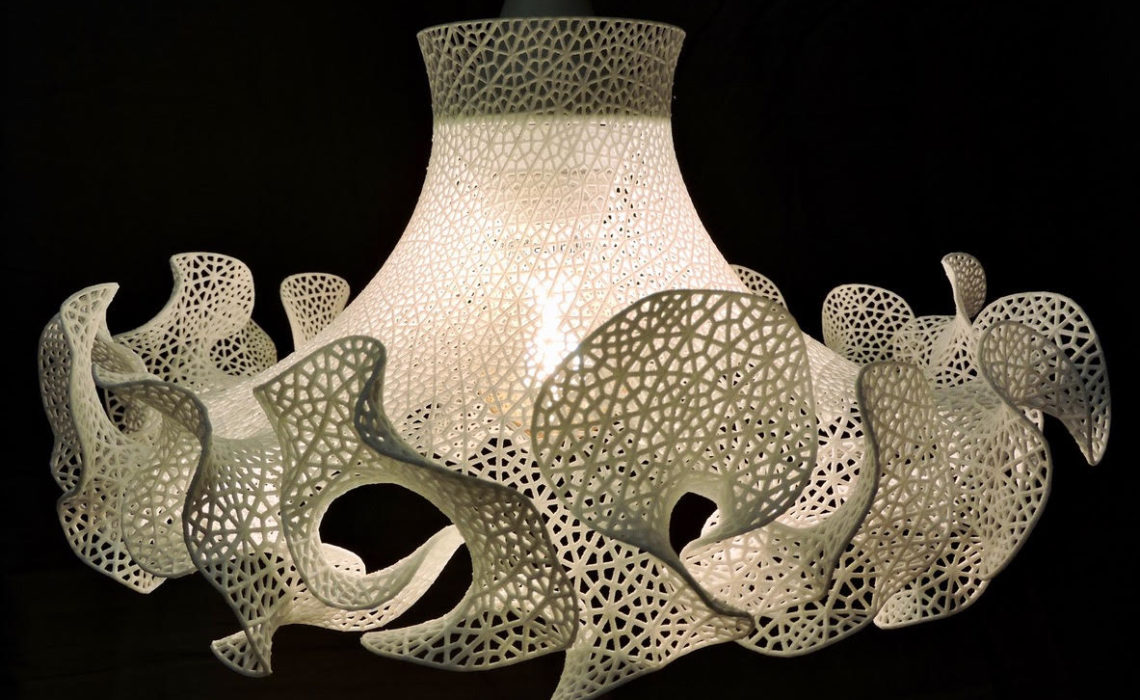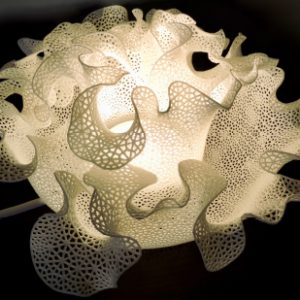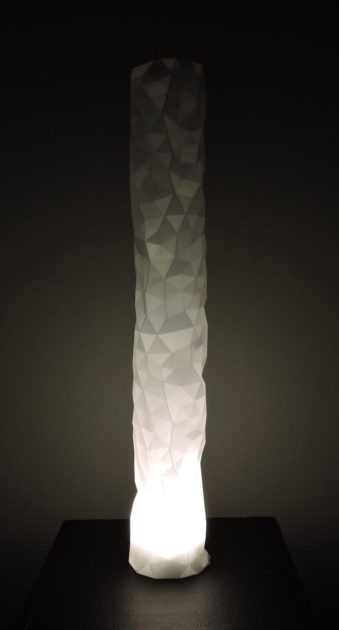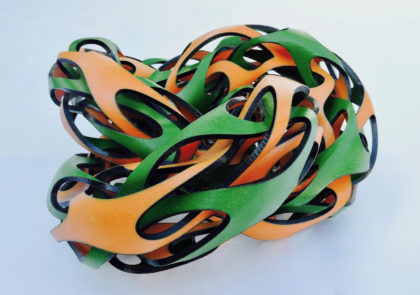
Have you ever wondered what would happen if a pipe were crushed by intense gravity, or expanded from the inside? Using distortions like these, artist David Bachman explores the ways that math can be used to expose the hidden identities of familiar shapes. In his first solo exhibition, Pattern, Symmetry, Growth and Decay, debuting November 10 at Los Angeles’ MorYork Gallery, he examines the ideas of expansion, contraction, and repetition via beautiful, twisting, richly patterned sculptures. We asked Bachman about his work and how his experiences as a mathematician inform his art.
Your work appears to have come from another world, but it’s very rooted in basic, familiar forms. Can you describe the process that turns kale into Kale, a cylinder into Decay?

Agave, printed in Shapeways’ White, Strong & Flexible. 9.7 x 9.7 x 4.5 in.
Much of my work is about creating complexity from a simple starting point. The pieces in the show are grouped into four different categories, according to the way this happens.
In the Growth and Decay series, I begin with simple forms and subject them to simulated forces to change them into something interesting.
In Decay, the starting form is a cylinder, which is subjected to an external simulated-gravity, causing it to partially buckle. In Growth, the forces are internal expansions which cause simple shapes like disks and cylinders to twist and expand in unpredictable ways.
In the other two series of pieces, Pattern and Symmetry, I start with a small, simple 3-dimensional shape, and force that motif to repeat in space. The repetition happens either by simple patterning over a surface, or by applying various reflections and rotations.

Crumple, printed in Shapeways’ White, Strong & Flexible. 4 x 4 x 23.2 in.
Can you describe the genesis of your art? Was it an outgrowth of your mathematical research, or did you want to be an artist all along? How did 3D printing play a part?
I did have some interest in drawing and painting when I was young, but didn’t do much about it until recent years.
I started experimenting with 3D printing primarily as a way to create classroom demonstration models in my university classes. Shortly after that, I started co-teaching classes on 3D design with some of our art faculty, and that led me to doing some artistic explorations on my own.
Since then I’ve really become enamored with the idea of using mathematics as a tool for design. 3D printing is the only technology that can turn my designs into physical realities.
How did your upcoming exhibition at MorYork come about? What’s the primary theme or focus on the show?
MorYork is the studio and gallery of artist Clare Graham. Clare had seen my work before, and contacted me several years ago about doing a series of polyhedra. Since then we’ve become friends, and a few months ago he offered to show my work in his gallery.
Tell us about why you chose the White Strong & Flexible nylon plastic material to bring your designs to life.
Half of the pieces in the show are White Strong & Flexible, and half are full color sandstone. Both of those are available in large enough sizes for gallery pieces. WSF is ideal for lampshades, because of its low weight and translucency. Sandstone has the advantage of being available in full color. Its higher weight gives it a solid feel, which is desirable for sculptural pieces.
Where can we find your work, outside MorYork?
I post most of my work on my website and at my shapeways shop, www.shapeways.com/shops/Bachman.

Trefoiled, printed in Shapeways’ Coated Full Color Sandstone. 9.1 x 9.5 x 4.5 in.
Any advice for the many people who are coming into their own as artists, thanks to 3D printing?
3D printing allows us to create objects with complex geometries, which are not possible to fabricate in any other way. However, to really take advantage of this power you have to develop proficiency with some design software, just like the way an aspiring painter has to master the use of a paintbrush. Each software package has strengths and weaknesses, so do a little research first to find one that suits your artistic practices.
If you’ll be in Los Angeles on Nov. 10, don’t miss opening night of David’s exhibition. All the details can be found here.
Cover image:
Hyperbole
Shapeways’ White, Strong & Flexible
10.9 x 11.4 x 5.9 in.

